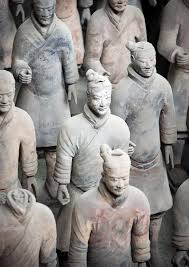
The Terracotta Army: Guardians of the Qin Dynasty
The Terracotta Army, also known as the "Terracotta Army of the First Emperor of Qin" or the "Qin Shi Huang Mausoleum Terracotta Army", is a sight to behold. Located in Xiyang Village, Lintong District, Xi'an City, Shaanxi Province, China, it stands as a testament to the power and ambition of the Qin Dynasty.
A Dynasty's Legacy in Clay
These life-sized terracotta figures weren't just randomly assembled. They were meticulously crafted to guard the tomb of Qin Shi Huang, the first emperor of a unified China. Constructed over 39 years, from 246 BCE to 208 BCE, the mausoleum itself is a marvel of ancient engineering and design.
The Scale of Imperial Ambition
Qin Shi Huang's tomb isn't just a burial site; it's a city unto itself. The existing burial mound alone towers at 76 meters high. Modeled after his capital, Xianyang, the tomb complex sprawls across a vast area, divided into an inner and outer city:
- Inner City: Encompassed by a wall with a perimeter of 2.5 kilometers, this area likely housed the emperor's burial chamber and other crucial structures.
- Outer City: Extending the reach of the complex, the outer city boasts a perimeter of 6.3 kilometers. It's here that archaeologists discovered the awe-inspiring pits containing the Terracotta Army.
More Than Just Soldiers
While the army of warriors is the most iconic feature, the pits also revealed much more. Chariots, horses, and even figures of entertainers and officials paint a vivid picture of life in the Qin Dynasty. Each figure is unique, showcasing an incredible level of detail and artistry in their features, attire, and even hairstyles.
A Window into the Past
The Terracotta Army isn't merely a collection of statues; it's a time capsule offering invaluable insights into ancient Chinese civilization. The craftsmanship, military strategies depicted, and social hierarchy reflected in the figures provide historians and archaeologists with a wealth of information about this pivotal period in Chinese history.
Q&A
1. When was the Terracotta Army built?
The Terracotta Army was constructed during the reign of Qin Shi Huang, between 246 BCE and 208 BCE.
2. What is the purpose of the Terracotta Army?
The Terracotta Army was designed to protect and serve Emperor Qin Shi Huang in the afterlife, reflecting the ancient Chinese belief in a spirit world mirroring the earthly realm.
3. Why is the Terracotta Army considered such a significant archaeological discovery?
The Terracotta Army offers unparalleled insights into the military organization, cultural practices, and artistic skills of the Qin Dynasty. It serves as a unique and invaluable window into ancient Chinese civilization.